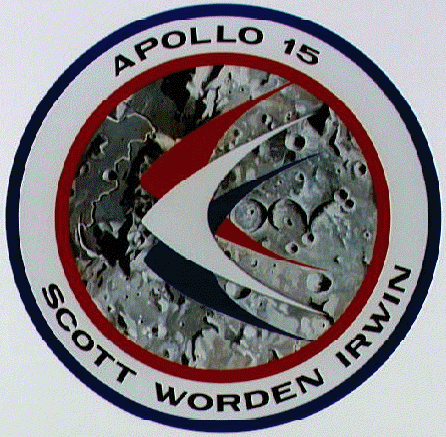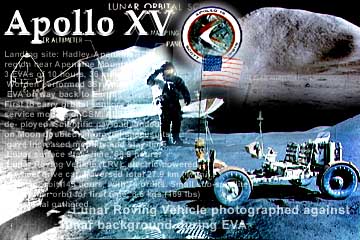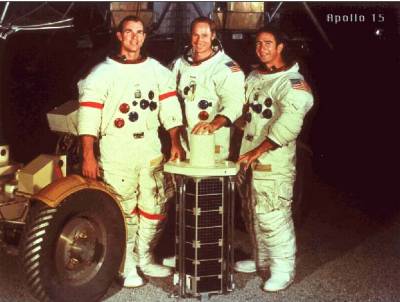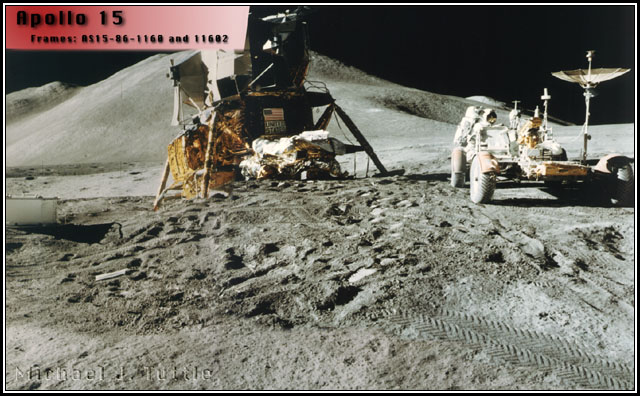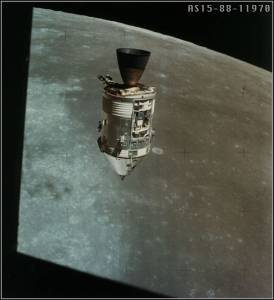
|
||||||||||||
|
|
Apollo 15
Launched: 26 July 1971 UT 13:34:00
(09:34:00 a.m. EDT)
David R. Scott, commander
Apollo 15 was the fourth mission in which humans walked on the lunar surface and returned to Earth. On 30 July 1971 two astronauts (Apollo 15 Commander David R. Scott and LM pilot James B. Irwin) landed in the Hadley Rille/Apennines region of the Moon in the Lunar Module (LM) while the Command and Service Module (CSM) (with CM pilot Alfred M. Worden) continued in lunar orbit. During their stay on the Moon, the astronauts set up scientific experiments, took photographs, and collected lunar samples. The LM took off from the Moon on 2 August and the astronauts returned to Earth on 7 August. Mission Profile Apollo 15 launched on 26 July 1971 at 13:34:00 UT (9:34:00 a.m. EDT) on Saturn V SA-510 from Pad 39A at Kennedy Space Center. The spacecraft was inserted into Earth orbit at 13:45:44 UT and translunar injection took place at 16:30:03 UT. The CSM separated from the S-IVB stage at 16:56:24 UT and docked with the LM at 17:07:49 UT. The S-IVB stage was released and burns at 19:22 UT and 23:34 UT sent the stage into a lunar impact trajectory. (It impacted the lunar surface on 29 July at 20:58:42.9 UT at 1.51 S, 11.81 W with a velocity of 2.58 km/s at a 62 degree angle from the horizontal.) A short was discovered in the service propulsion system and contingency procedures were developed for using the engine. A mid-course correction was performed on 27 July at 18:14:22 UT and another on 29 July at 15:05:15. During cruise it was discovered that the LM range/range-rate exterior glass cover had broken and a small water leak had developed in the CM requiring repair and clean-up. The SIM door was jettisoned at 15:40 UT and lunar orbit insertion took place at 20:05:47 UT. The descent orbit maneuver was executed at 00:13:49 UT on 30 July.
Scott and Irwin entered the LM and the LM-CSM undocking maneuver was initiated at 17:48 UT but undocking did not take place. Worden found a loose umbilical plug and reconnected it, allowing the LM to separate from the CSM at 18:13:30 UT. The LM fired its descent engine at 22:04:09 UT and landed at 22:16:29 UT on 30 July 1971 in the Mare Imbrium region at the foot of the Apennine mountain range at 26.1 N, 3.6 E. Scott and Irwin made three moonwalk EVAs totaling 18 hours, 35 minutes. During this time they covered 27.9 km, collected 76.8 kg of rock and soil samples, took photographs, and set up the ALSEP and performed other scientific experiments. This was the first mission which employed the Lunar Roving Vehicle which was used to explore regions within 5 km of the LM landing site. After the final EVA Scott performed a televised demonstration of a hammer and feather falling at the same rate in the lunar vacuum. The CSM remained in a slightly elliptical orbit from which Worden performed scientific experiments.
The LM lifted off from the Moon at 17:11:22 UT on 2 August after 66 hours, 55 minutes on the lunar surface. After the LM docked with the CSM at 19:09:47 UT the lunar samples and other equipment were transferred from the LM. The LM was jettisoned at 01:04:14 UT on 3 August, after a one orbit delay to ensure LM and CSM hatches were completely sealed. The LM impacted the Moon on 3 August 03:03:37.0 UT at 26.36 N, 0.25 E, 93 km west of the Apollo 15 ALSEP site, with an estimated impact velocity of 1.7 km/s at an angle of ~3.2 degrees from horizontal. Experiments were performed from orbit over the next day. After Apollo 15 underwent an orbit-shaping maneuver the scientific subsatellite was spring-launched from the SM SIM bay at 20:13:19 UT on 4 August into a 102.0 x 141.3 km lunar orbit. Transearth injection began on the next orbit with a 2 minute, 21 second main engine burn at 21:22:45 UT. On 5 August, Worden carried out the first deep space EVA when he exited the CM and made three trips to the SIM bay at the rear of the SM to retrieve film cannisters and check the equipment. Total EVA time was 38 minutes, 12 seconds. The CM separated from the SM at 20:18:00 UT on 7 August. During descent, one of the three main parachutes failed to open fully, resulting in a descent velocity of 35 km/hr (21.8 mph), 4.5 km/hr (2.8 mph) faster than planned. Apollo 15 splashed down in the Pacific Ocean on 7 August 1971 at 20:45:53 UT (4:45:53 p.m. EDT) after a mission elapsed time of 295 hrs, 11 mins, 53 secs. The splashdown point was 26 deg 7 min N, 158 deg, 8 min W, 330 miles north of Honolulu, Hawaii and 9.8 km (6.1 mi) from the recovery ship USS Okinawa. Performance of the spacecraft, the first of the Apollo J-series missions, was excellent for most aspects of the mission. The primary mission goals of exploration of the Hadley-Appenine region, deployment of the ALSEP and other scientific experiments, collection of lunar samples, surface photography, and photography and other scientific experiments from orbit, and engineering evaluation of new Apollo equipment, particularly the rover, were achieved. Scott, 39, was an Air Force Colonel on his third spaceflight (he'd flown previously on Gemini 8 and Apollo 9), Worden, 39, was an Air Force major on his first spaceflight, and Irwin, 41, was an Air Force lt. colonel also on his first spaceflight. The backup crew for this mission was Richard Gordon, Vance Brand, and Harrison Schmitt. The Apollo 15 command module "Endeavor" is on display at the USAF Museum at Wright-Patterson Air Force Base, Dayton, Ohio. Credit NASA |
